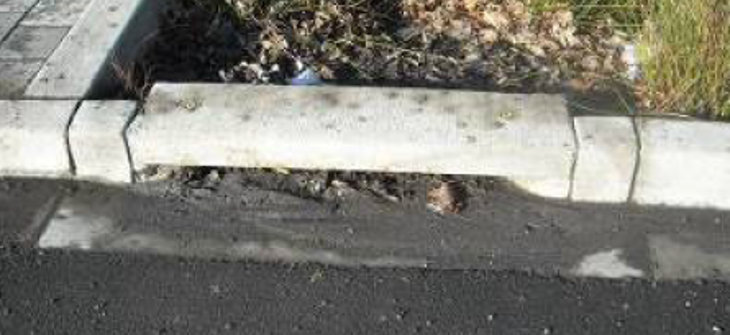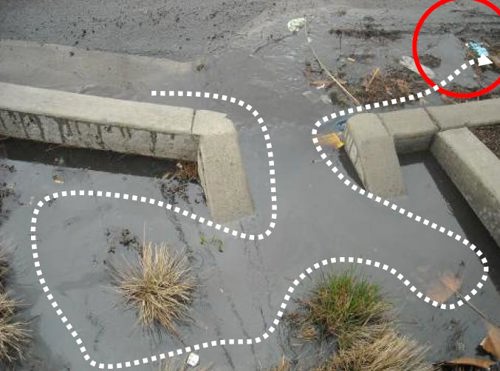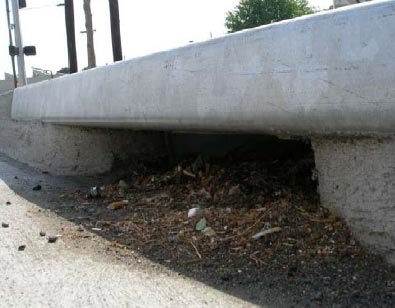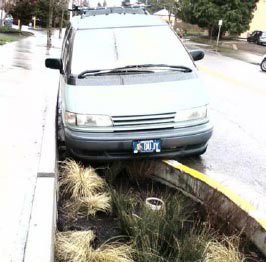
Bioretention Part Three: Lessons Being Learned – Siting Issues and Inlet Design
Bioretention Part Three: Lessons Being Learned – Siting Issues and Inlet Design
Not done with siting issues yet, maybe this becomes five parts? One issue on siting and design is the hydraulic grade lines. Recall from your road drainage days the equations that were used to space catch pits and throat openings? The equations allowed for you to estimate gutter efficiency and top width for specified design storms. Well, these equations still apply, and I am thinking maybe even more considerations for very low flows.

In this photo, the HGL is too flat, and there is very little storage capacity in the filter bed. Hence, the flows can meander through the facility and fail to capture pollutants. Also, small inlets on steeper slopes result in substantial bypassing of the facility before the storage capacity is utilized. In some instances, the inlets are placed on the super-elevated portion of a curve road and runoff does not reach the facility at all.
While maybe not a concern for inlets design solely for the purpose of conveyance, the issue of careful grading is looking to be very important. From personal observations, very small elevations differences between the edge of pavement and the edge of curb have a big impact on small flows, for which many of these BMPs are design to capture. Frequently, the edge of asphalt is as little as 6 mm below the invert of the concrete inlet, or there is a small temperature gap between the asphalt and the edge of the curb. Even these small differences will allow the low flow runoff to completely bypass the unit. These are mostly construction and specification related issues but need to be addressed.
Inlet Design Inlet design is a vexing issue. Frequently, inlets are too small and allow for bypassing and clogging with trash and debris or street leaves. Accumulation of these pollutants on the outside of the inlet become and obstruction to entry and cause bypassing of the flows to downstream appurtenances. Sometimes trash and debris get jammed in the throat of the inlet.
Inlet design is a vexing issue. Frequently, inlets are too small and allow for bypassing and clogging with trash and debris or street leaves. Accumulation of these pollutants on the outside of the inlet become and obstruction to entry and cause bypassing of the flows to downstream appurtenances. Sometimes trash and debris get jammed in the throat of the inlet.
Lastly, is the issue of accumulated sediment just inside the inlet. When water gets through the inlet, its energy level goes way down, and the heavier settleable solids  and trash and debris accumulate right there. This hydraulic effect builds sediment up to the point where runoff is effectively blocked from the inside and is caused to bypass.
and trash and debris accumulate right there. This hydraulic effect builds sediment up to the point where runoff is effectively blocked from the inside and is caused to bypass.
Some effective design techniques allow for more storage capacity at the inlet. Sometimes a sediment forebay is built in with an interior flow spreader to take the settled water and spread it evenly over the surface of the bioretention media. This consideration is especially important to consider with the land use associated with the design. Heavily travelled commercial roadways will most likely transport larger particles and heavier loads. If you believe that TSS constitutes the total mass load of solids being transported in stormwater runoff, you need to reevaluate.
The City of Portland has been gaining a lot of experience with different designs and figuring out what works and what does not. Some innovative practices have been the result. Since roads and parking lots are deemed car habitat, we need to consider issues such as traffic safety and parking. The city found that in many cases an open curb design could be a bit of an issue. In the photo below the lack of a wheel stop makes for some interesting parking. The City developed a mountable wheel stop to address this problem. Newer design are also more effective at capturing runoff, managing solids, etc.
Next month I plan to switch to discussing media, one of my favorite subjects.
